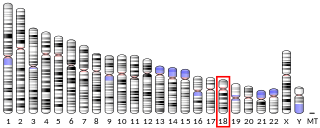Acetyl-coenzyme A transporter 1 also known as solute carrier family 33 member 1 (SLC33A1) is a protein that in humans is encoded by the SLC33A1 gene. [5]
Acetyl-coenzyme A transporter 1 also known as solute carrier family 33 member 1 (SLC33A1) is a protein that in humans is encoded by the SLC33A1 gene. [5]
The protein encoded by this gene is required for the formation of O-acetylated (Ac) gangliosides. The encoded protein is predicted to contain 6 to 10 transmembrane domains, and a leucine zipper motif in transmembrane domain III. [5]
Defects in this gene have been reported to cause spastic paraplegia autosomal dominant type 42 (SPG42) in one Chinese family, but not in similar patients of European descent. [5]
Hereditary spastic paraplegia (HSP) is a group of inherited diseases whose main feature is a progressive gait disorder. The disease presents with progressive stiffness (spasticity) and contraction in the lower limbs. HSP is also known as hereditary spastic paraparesis, familial spastic paraplegia, French settlement disease, Strumpell disease, or Strumpell-Lorrain disease. The symptoms are a result of dysfunction of long axons in the spinal cord. The affected cells are the primary motor neurons; therefore, the disease is an upper motor neuron disease. HSP is not a form of cerebral palsy even though it physically may appear and behave much the same as spastic diplegia. The origin of HSP is different from cerebral palsy. Despite this, some of the same anti-spasticity medications used in spastic cerebral palsy are sometimes used to treat HSP symptoms.
Glucose transporter 1, also known as solute carrier family 2, facilitated glucose transporter member 1 (SLC2A1), is a uniporter protein that in humans is encoded by the SLC2A1 gene. GLUT1 facilitates the transport of glucose across the plasma membranes of mammalian cells. This gene encodes a major glucose transporter in the mammalian blood-brain barrier. The encoded protein is found primarily in the cell membrane and on the cell surface, where it can also function as a receptor for human T-cell leukemia virus (HTLV) I and II. One good source of GLUT1 is erythrocyte membranes. GLUT1 accounts for 2 percent of the protein in the plasma membrane of erythrocytes. GLUT1, found in the plasma membrane of erythrocytes, is a classic example of a uniporter. After glucose is transported into the erythrocyte, it is rapidly phosphorylated, forming glucose-6-phosphate, which cannot leave the cell. Mutations in this gene can cause GLUT1 deficiency syndrome 1, GLUT1 deficiency syndrome 2, idiopathic generalized epilepsy 12, dystonia 9, and stomatin-deficient cryohydrocytosis.

The human gene SPAST codes for the microtubule-severing protein of the same name, commonly known as spastin.

GM2 ganglioside activator also known as GM2A is a protein which in humans is encoded by the GM2A gene.

Atlastin, or Atlastin-1, is a protein that in humans is encoded by the ATL1 gene.

Paraplegin is a protein that in humans is encoded by the SPG7 gene located on chromosome 16.

Spartin is a protein that in humans is encoded by the SPG20 gene.

Sodium bicarbonate transporter-like protein 11 is a protein that in humans is encoded by the SLC4A11 gene.

Kinesin heavy chain isoform 5A is a protein that in humans is encoded by the KIF5A gene.

Non-imprinted in Prader-Willi/Angelman syndrome region protein 1 is a protein that in humans is encoded by the NIPA1 gene. This gene encodes a potential transmembrane protein which functions either as a receptor or transporter molecule, possibly as a magnesium transporter. This protein is thought to play a role in nervous system development and maintenance. Alternative splice variants have been described, but their biological nature has not been determined. Mutations in this gene have been associated with the human genetic disease autosomal dominant spastic paraplegia 6.

KIAA0196 is a human gene. The product is a protein that is a component of the WASH complex, which regulates actin assembly on intracellular vesicles. Mutations in KIAA0196 are implicated in some forms of hereditary spastic paraplegia.

Maspardin is a protein that in humans is encoded by the SPG21 gene.

Spatacsin is a protein that in humans is encoded by the SPG11 gene.

Aldehyde dehydrogenase 16 family, member A1 also known as ALDH16A1 is an aldehyde dehydrogenase gene.

Vesicular glutamate transporter 3 (VGLUT3) is a protein that in humans is encoded by the SLC17A8 gene.

AFG3 ATPase family gene 3-like 2 is a protein that in humans is encoded by the AFG3L2 gene.

Fatty acid 2-hydroxylase is a protein that in humans is encoded by the FA2H gene.
Spastic paraplegia 9 is a protein that in humans is encoded by the SPG9 gene.

Zinc finger, FYVE domain containing 26 is a protein that in humans is encoded by the ZFYVE26 gene.

Zinc finger, FYVE domain containing 27 is a protein that in humans is encoded by the ZFYVE27 gene.
This article incorporates text from the United States National Library of Medicine, which is in the public domain.